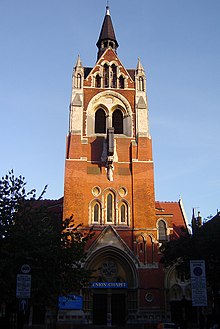Union Chapel, Islington
| Union Chapel | |
|---|---|
 October, 2006 photo of the Union Chapel | |
 | |
| 51°32′41″N 0°06′09″W / 51.544707°N 0.102503°W | |
| Address | London Borough of Islington |
| Country | England |
| Denomination | Congregationalist |
| Website | www.unionchapel.org.uk |
| Architecture | |
| Architect(s) | James Cubitt |
| Clergy | |
| Minister(s) | Karen Stallard |
Union Chapel is a working church, live entertainment venue and charity drop-in centre for the homeless in Islington, London, England. Built in the late 19th century in the Gothic revival style, the church is Grade I-listed.
The Venue
The church hosts live music and comedy events, and was voted London's Best Live Music Venue by readers of Time Out magazine in 2012.[1]
Margins Homelessness Project
The Margins Project, based in the Union Chapel, provides a range of support services to people facing homelessness, crisis and isolation. It operates a Sunday drop-in that provides meals, showers and laundry facilities. It also offers help with accessing housing, employment and health services and weekly art classes.[2]
Church in the Chapel
Union Chapel is a Congregational church, which describes itself as "liberal, inclusive, non-hierarchical, and non-conformist" and meets every Sunday for worship.[3] The church is also open on Wednesday mornings for private prayer, and a Bible study group meets Wednesday lunchtime.
History
The congregation first met in 1799 in a house in Highbury Grove as a union of evangelical Anglicans and non-conformists, and moved to a previous building on the present site in Compton Terrace, just off Upper Street, in 1806. The current building is in the Victorian gothic style of architecture. It was designed by James Cubitt and built between 1874 and 1877, with further additions from 1877 to 1890, while Henry Allon was pastor.[4] The chapel was used for a major scene in the 1982 film, Who Dares Wins. Since 1982, the charity Friends of Union Chapel has helped restore and preserve the church and organise activities.[5]
Ministers
- Thomas Lewis 1804–1852
- Henry Allon 1844–1892
- Hardy Harwood 1891–1914
- Ronald Taylor 1940–1980
- Gareth Trevor Jones 1981–1986
- Janet Wootton 1987–?
- Karen Stallard 2010–current
Organ
The organ dates from 1877 and is by Henry Willis & Sons. It was restored in 1946 by Monk & Gunther[6] and by Harrison & Harrison in 2013.
Organists
- John Henry Gauntlett 1852–1861
- Ebenezer Prout 1861–1873
- Fountain Meen 1880–1909
- John Hooker 1973–2002
References
- ^ "London's top 20 music venues revealed". Time Out. Retrieved 17 February 2013.
- ^ "Welcome to the Margins Project". Chapel website. Retrieved 17 February 2013.
- ^ "Union Chapel - Church". Retrieved 17 February 2013.
- ^ "History of Union Chapel". Chapel website. Retrieved 17 February 2013.
- ^ "Who the Friends are". Chapel website. Retrieved 17 February 2013.
- ^ "Union Chapel". National Pipe Organ Register. Retrieved 17 February 2013.
Further reading
- Cherry, Bridget, ed. (2007), Dissent and the Gothic Revival: papers from a study day at Union Chapel, Islington, London: The Chapels Society ISBN 9780954506117 Includes: The building of Union Chapel / Anthony Richardson -- 'The most vital bonds of union', Union Chapel and Congregationalism / Clyde Binfield—The Union Chapel archives and library / Richard Wallington.
